Electronic Shelf Tags: Advancing the Future of Electronic Shelf Labels (ESLs) and Price Label Technology
15 Feb 2024
Electronic Shelf Tags and Labels: How Do ESLs Systems Work?
Electronic Shelf Labels (ESLs), also known as electronic shelf tags, leverage e-paper technology and wireless communication to dynamically display product and pricing information at the retail shelf edge, effectively replacing traditional paper labels.
These electronic price labels connect to a central hub, enabling real-time price and information updates across a store’s network. This advanced system reduces manual labor, ensures pricing accuracy, and enhances customer engagement by providing immediate access to current promotions and stock levels.
Additionally, Electronic Shelf Labels are highly energy-efficient, supporting sustainable operations and facilitating dynamic pricing strategies through seamless integration with inventory management systems. This capability not only helps manage resources better but also optimizes pricing to adapt swiftly to market changes, making ESLs a crucial tool for modern retail environments.
Electronic Shelf Tags vs. Paper Price Tags: A Comparison Chart of Electronic Shelf Labels (ESLs) Systems
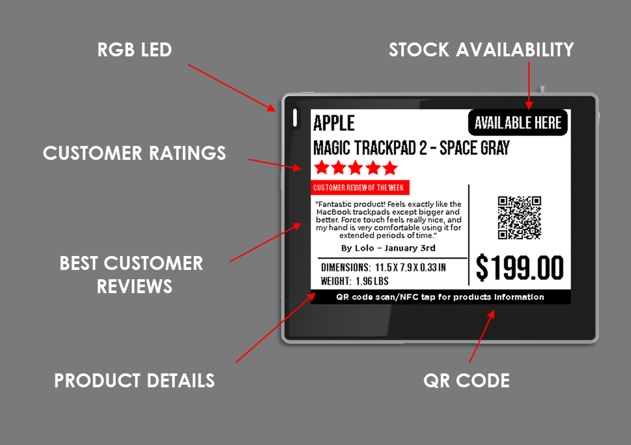 Compared to Paper price tags, Electronic shelf labels (ESLs) offer more efficiency, accuracy, flexibility, and environmental friendliness in retail settings.
Compared to Paper price tags, Electronic shelf labels (ESLs) offer more efficiency, accuracy, flexibility, and environmental friendliness in retail settings.
These electronic shelf tags represent a significant advancement over traditional paper price tags in the retail industry. Unlike paper tags, ESLs provide real-time updates and dynamic pricing capabilities, which not only reduce labor costs but also enhance operational efficiency for retailers. Electronic shelf labels ensure accuracy and consistency in pricing information, greatly reducing the risk of human errors often associated with paper tags.
Additionally, ESLs offer greater flexibility and customization options, allowing retailers to swiftly adapt to market changes. More importantly, electronic shelf tags contribute to sustainability efforts by reducing paper waste and energy consumption.
Below is a comparison chart of ESLs and paper price tags, with detailed explanations of the benefits that electronic shelf labels provide following the table.
| Electronic Shelf Labels | Paper price tag | |
|---|---|---|
| Pricing Strategy | Best fit for dynamic pricing strategy and price change can be conducted remotely within few seconds | Relatively Slower, price change needs to be done manually and it might take one or two days to finish the change |
| Promotion(changing the price) | Easy and doesn't incur extra cost | Incur additional paper cost for changing the price |
| Transportation Cost (for transporting white paper) | No | Yes |
| Labor Cost when changing price | No | Yes |
| Accuracy | Higher | Lower |
| Pricing error | Lower, also the error is manageable and measurable with the help of electronic shelf labels system | Higher |
Electronic Shelf Tags: Ensuring Accurate Pricing Across Channels with Electronic Price Labels and ESLs
By integrating with e-commerce systems, Electronic Shelf Labels(ESLs): enable real-time updates that reflect consistent pricing across all channels. Known also as electronic shelf tags, this synchronization not only enhances the customer experience productively but also empowers retailers with dynamic pricing capabilities. These tags enable them to respond promptly to market conditions and optimize strategies for maximum profitability.
Additionally, Electronic Shelf Labels(ESLs): streamline operations by eliminating the need for manual price adjustments, freeing up staff to focus on delivering exceptional service and gaining valuable insights into pricing trends and consumer behavior. Ultimately, electronic shelf tags facilitate a synchronized approach to pricing management, enhancing efficiency and competitiveness in the ever-evolving retail landscape.
Electronic Shelf Tags and Labels(ESLs): Enhancing the Omnichannel Sales Experience with ESL Technology
Electronic shelf labels (ESLs), also known as electronic shelf tags, play a pivotal role in enhancing the omnichannel sales experience by seamlessly integrating online and offline retail channels. Through real-time pricing updates and accuracy, these electronic shelf tags ensure consistency across platforms, enabling features such as click-and-collect for convenient in-store pickups guided by ESLs.
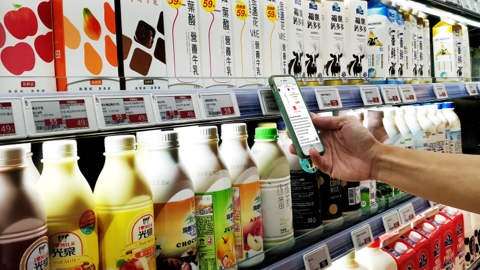
Additionally, Electronic Shelf Labels support personalized recommendations and targeted promotions based on customer data, fostering engagement and loyalty. By serving as a bridge between online and offline sales, Electronic Shelf Labels empower customers to access additional product information and ordering options, creating a seamless and convenient shopping journey.
Overall, Electronic Shelf Labels enhance the omnichannel sales experience by providing a cohesive and personalized shopping experience across all channels, driving sales and customer satisfaction.
Electronic Shelf Tags and Labels(ESLs):Decreasing Error Rates in Pricing
Electronic shelf tags can also improve product price and other information accuracy while eliminating human errors in traditional paper labeling and pricing. Accurate pricing across channels and standardized pricing systems will allow customers to no longer be disappointed and confused by price differences at different touch points across the store because electronic shelf tag operators can review changes and fix any pricing errors at any time. After integration with retail point-of-sale (POS), ESL systems can ensure the overall shelf product information and pricing are in perfect synchronization and consistency with those in the POS systems, contributing to better tailored promotion and advertising campaigns.
Electronic Shelf Tags and Labels(ESLs): Ensuring Cost-Effectiveness for Corporations
As for the costs of implementing electronic shelf labels, it might seem like a substantial investment to switch to the ESL system initially. However, using electronic shelf labels—often referred to as electronic shelf tags—actually results in significant cost savings compared to traditional price tags. By adopting electronic shelf tags, businesses can save on paper, transportation, printing, and labor costs. Additionally, whereas paper labels sometimes need to be manually replaced on the shelves even if the item is still in stock, with electronic shelf tags, updates can be made remotely with just a few clicks.
Lower costs and power consumption align well with corporate ideologies of cost-efficiency and environmental sustainability. In a world striving for carbon neutrality, electronic shelf tags provide substantial support by reducing the need for paper, thereby aiding in the reduction of logging and deforestation efforts. Gone are the days when staff had to wait in line at the copier, printing out reams of paper for promotional materials and price updates. E-ink technology used in ESLs achieves greater visibility with much less paper. Furthermore, the low power consumption of electronic shelf tags not only decreases carbon emissions but also potentially reduces carbon taxes from a corporate perspective, making ESLs an increasingly attractive option for modern businesses.
Electronic Shelf Tags and Labels(ESLs): Evolution Across Three Generations of ESLs ePaper
First generation of the electronic shelf tag: LCD and infrared communication
The first generation of Electronic Shelf Labels (ESLs) introduced LCD display technology coupled with infrared communication protocols. This combination provided clear and visually appealing displays for showcasing product information and pricing details in retail environments. Infrared communication facilitated seamless data transmission between the central management system and individual ESLs, ensuring timely updates and maintaining information accuracy throughout the store. These innovations laid the groundwork for subsequent advancements in Electronic Shelf Labels technology, paving the way for interactive displays and wireless communication protocols in later generations.
Second generation of the electronic shelf tag: E-paper and Infrared or radio communication
The second generation of the epaper display tag utilizes electronic paper (e-paper) technology, connected to communication technologies like 2.4GHz, Wi-Fi, ZigBee, or proprietary radio systems through access points or routers. These labels replace traditional paper labels and stickers. Each pigment particle inside the thin film of the ESL epaper display is electronically charged, displaying a different color. These particles form the fundamental elements of batteryless RFID-enabled tags. By utilizing radio or infrared (IR) communication with a back-end platform, administrators can efficiently update data on the epaper display tag for batch adjustments of store labels. This advancement enhances retail operational efficiency, provides better control over commodity information and price adjustments, and promotes investment and development of the epaper display tag solutions in the retail sector. The goal is to achieve breakthroughs and accelerate the application development of epaper display tags.

For higher retail operational efficiency and better control over commodity information and price adjustments, owners and entrepreneurs are actively investing in the application and development of Electronic Shelf Label solutions in the retail field, hoping to achieve breakthroughs and accelerate the epaper display tag application development.
Third generation of the electronic shelf tag: Planogram and picking
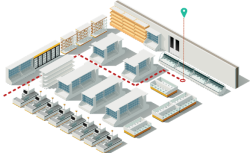
Thanks to the ESL epaper display tag and its radio technology, store management and staff can now be freed from the laborious task of locating products and changing paper labels and stickers. With a centralized platform, shelving staff have greater flexibility and precision in updating information for target products, including pricing, product placements, online order fulfillment, and planogram management on shelves. Employees can command sales remotely, generating a floor plan that allows shoppers to easily navigate the store. Guided by store PDAs or mobile apps, customers can swiftly find desired items following an optimized route. Online orders, whether single or bulk purchases, can be efficiently fulfilled. This revolutionizes the shopping experience by eliminating physical demands associated with shelving and shopping.
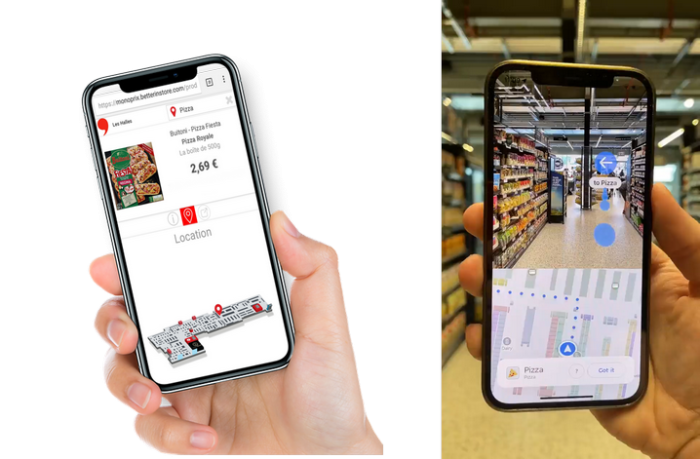
Now with the visual representation that demonstrates the precise placement and exact layout of products on various display points, planograms help keep stores highly efficient and maximize selling space with aesthetic appeal and category flows in consideration. Boutique and retailers, small or large, can also benefit from planograms’ visual appeal while taking into account merchandising principles and sales performance. Using planograms is simply like reading the pages of a book in which shoppers can have a clear grasp of the merchandise and determine how much inventory the stores have for each product through the consistency created between store locations, and the product pairing suggestions promoted by the stores.
Future Trends: The Growth and Industry Applications of Electronic Shelf Tags and ESL Technology
Key Factors Driving Electronic Shelf Labels (ESLs) Growth Across Industries
Key factors driving the growth of Electronic Shelf Labels (ESLs) include the dynamic applications across various industries. For example, electronic shelf tags offer marketing flexibility in pricing and sales campaigns, fostering innovation where new ideas emerge. For umbrella retailers, this means proactively promoting rain gear on rainy days. Additionally, excessive food waste has long been a major issue for food producers.

The dynamic information and pricing capabilities of electronic shelf tags equipped with wireless technology can address this problem. Sensors on the tags read the IC information of perishable goods to track expiration dates, enabling timely adjustments to pricing. This feature of Electronic Shelf Labels not only helps to prevent consumable food from being wasted but also supports efforts to reduce hunger. By allowing for real-time price adjustments based on product shelf life, electronic shelf tags play a crucial role in reducing waste and enhancing efficiency in retail settings.
Versatile Applications of Electronic Shelf Tags: Enhancing Industries with ESLs and Electronic Price Labels
ESL applications, facilitated by electronic shelf tags, can be envisioned across various industries, including automotive and transportation, hospitals and healthcare, public and private institutions, and educational sectors, extending even to personal consumer and wearable electronics. Electronic paper display tag technology, underpinned by electronic shelf tags, has become an indispensable tool due to the critical need for fast information exchange in modern life.
In healthcare settings, hospitals will improve life-saving communication between caretakers, patients, and their families through the use of electronic shelf tags that ensure crucial information is always current and visible. Traffic systems will benefit from more precise transportation schedules with accurate dispatches and well-organized mass transit arrangements, thanks to the reliable and dynamic updating capabilities of electronic shelf tags.
These improvements represent just a few of the fundamental applications of electronic shelf tags, as ongoing development and implementation continue to expand their use across more sectors.
Pervasive Displays: Choosing the Right Electronic Shelf Tags and Labels for ePaper Display Solutions
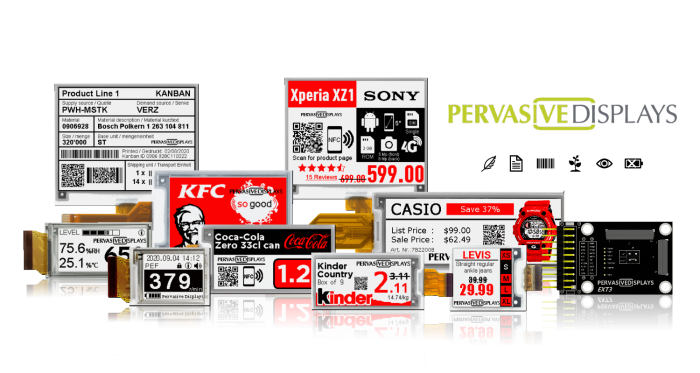
Who is Pervasive Displays
Pervasive Displays is the leader in e-paper displays for IoT applications, it designs, manufactures and markets e-paper displays that deliver high resolution, ultra-thin form factor, sunlight readability and ultra-low power consumption. Pervasive Displays provides suitable solutions for businesses which hope to gain use of ESL epaper technology.
What can Pervasive Displays provides
Pervasive Displays Inc. (PDI) offers specialized custom services, complete post-sales service, high-quality EPD modules and various EPD development kits to fully optimize customer’s operation process and improve customer’s production efficiency. Pervasive has served ESL solution providers around the world for over 13 years, and has become the EPD module manufacturer and designer with the most ESL shipments. PDI’s full collection of EPD models from 1.54” to 12”, with various temperatures ranging from freezer to cool room, will custom make your storefront, help develop more IoT, in-store and innovative applications, and turn your physical environment into a digital asset.
An Epaper display tag revolutionize the retail industry by replacing traditional paper tags with ESL epaper. ESLs offer cost savings, improved operational efficiency, and enhanced customer experiences. With their ability to remotely update information and facilitate omnichannel sales, ESLs are driving the future of retail towards greater sustainability and convenience.
Category: Blog
Back to News